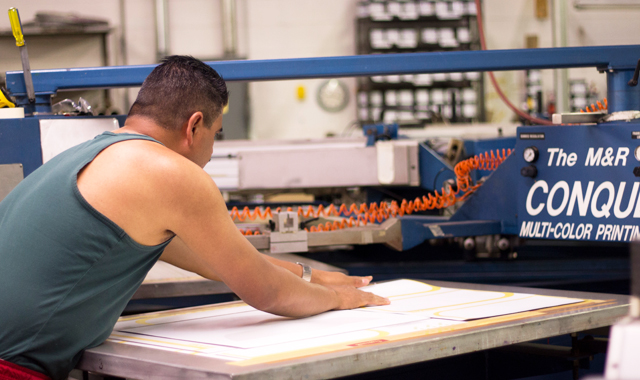Technology is a driving force in the printing industry. Those who employ it wisely find success. Learn how this business pulls ahead of the competition by investing in solid technologies.

John Downs credits flexibility and exceptional customer service with keeping Rockford Silk Screen Process, 6201 Material Ave. in Loves Park, afloat through difficult times.
Despite a rough economy and many technological changes, the business that Downs co-owns with his sister, Jean Keding, has adapted steadily with the times.
In its early days, Rockford Silk Screen Process did a lot of work for industrial customers – making panels, nameplates – until the 1980s, when many customers either moved away or closed their doors. To stay in business, the firm had to find new markets.
“When we bought the business in ’93, we decided we wanted to manage it, rather than work in the production end,” says Downs. “We invested a lot of money in new presses and moved from single-color nameplates to more point-of-purchase display-type work.”
It’s that investment in newer technology that has driven the company’s success, Downs believes. Sales were up 30 percent last year, thanks in large part to research and development projects that came to fruition after two or three years. Most years, Downs aims for growth of about 10 percent.
From concept to completion, Rockford Silk Screen Process is capable of producing a wide variety of printed products, from eye-catching signs to banners, nameplates, stickers, labels and much more. Some clients are located around the world, but most are closer to home.
“Rockford, Chicago and Madison have no shortage of printers, but few can offer the exceptional skill, quality and service we can,” Downs says. “We know that the print products our clients present are a reflection of their businesses, and that’s why we’re dedicated to exceeding their expectations.”
Downs and Keding bought the firm in 1993 from their parents, Marvin and Kay Downs, who had purchased it in 1963.
“We’ve both worked here most of the time since we were in high school,” Downs says. “When our father bought the business, it was about 1,000 square feet in a house. Today, we have about 90,000 square feet.”
Since those early days, technology has quickened the pace of work dramatically.
“We went from printing by hand to two six-color presses,” Downs says. “We do more printing in one day than our parents could do in a whole year.”
As technologies evolve, Downs stands by the silkscreen printing method, which he says is more reliable for his customers than lithographic or offset printing.
In screen printing, a woven mesh is used to support an ink-blocking stencil, which has open areas where ink is transferred onto a surface. A fill blade or squeegee is moved across the screen, forcing ink through the openings in the mesh to wet the printing surface. One color is printed at a time, so several screens are needed to produce a multi-colored image.
The lithography process uses flexible aluminum plates to print an image. Offset printing takes that process one step further, by transferring (or offsetting) the image from a plate to a rubber blanket, then on to the printing surface.
Downs says the screen-printing process delivers rich, bold, brilliant colors. It also works well with various specialty inks, such as metallic, magnetic and chalkboard. Screen printing can be applied to a wide variety of surfaces and produces a very durable end result. Typical offset or litho prints left outdoors last only three or four months, while screen-printed materials last a minimum of two years. Several types of laminates or clear coat sealers can extend the lifecycle to five years or more.
Some of Downs’ most valuable customers are agricultural companies such as Monsanto, Syngenta, Asgrow and DeKalb. He credits these successes to the durability of his end product.
“Most of the stuff we do requires a lot of color and is exposed to the elements,” he explains. “Screen printing offers better durability because of the pigmented ink we use.” Those pigmented inks contain solid, opaque particles that help color to endure.
In about 90 percent of Downs’ products, additional fabrication is involved, such as laser cutting or CNC machining.
Downs takes pride in solving problems for his customers and has been especially successful at this within the agriculture sector.
“We used to ship to DeKalb facilities and the companies would distribute the signs, but they wanted a better way for farmers and dealers to order the signs,” Downs says. “We developed a portal on our website so they could order directly from us. From that, we built a website specifically for the ordering of those signs and then we ship directly to the site where they will be used.” Rockford Silk Screen Process provides complete kits for assembly – the printed signage, any additional printings, poles and fasteners. The kits are sent directly to the farm or other site where they will be used, rather than to a distributor or dealer.
And that’s just one customer. “Every customer has a different story,” he says. “You have to find out how you can be of service.”
Although his agricultural customers generate strong volume, their needs are seasonal. To keep up with the spike in demand, Downs’ full-time staff of 43 swells with temporary help in the spring, when agricultural orders are printed and shipped. In these jobs, it’s not necessary to have experience in the printing industry, but it certainly helps.
“It helps to have training as a printer,” says Downs. “But we look for people who are color-oriented with a good eye for color. We definitely look for people who are artistic and have some computer experience.”
Along with agricultural customers, Downs serves many commercial clients. He prints signs for Walgreens and point-of-purchase displays found at stores like Lowe’s and Home Depot.
“We often do work for the product manufacturers rather than the retailers themselves,” he says.
To keep business at a steady level, year-round, Downs constantly looks for ways to diversify. He hopes to add more industrial work like the machine nameplates his company printed in the early days.
“There’s a tremendous amount of work out there for those of us who survived the recession,” Downs says.
The printing industry is a hotbed of continual innovation. One emerging technology is an ink-jet printer unlike any you’ll find in your home or office. This printer is a grand format of 48-by-96 inches and is capable of shooting out weather-resistant inks.
Compared with silkscreening, ink-jet printing is faster and requires less lead time, Downs says. It’s designed for quicker turnarounds in smaller quantities and also serves the high-resolution four-color process market.
Even with faster technology, Downs admits there are some customers better served by quick-print sign shops – those looking for just one or two banners, for example.
“I’m always upfront about the cost involved for setup,” says Downs. “People may think I’m inflating the numbers, but our costs are high for one banner. If that’s all that you need, it will be expensive using any process.”
Downs and Keding continue to invest in new technologies, as they pursue techniques to make their business better, faster and more efficient.
That goes for technology in the drying process, too. Downs is considering converting from UV to LED lights, which run cooler and more efficiently.
“Others who’ve done it have cut their electric bills to one-tenth,” says Downs. “That’s a huge cost savings.”
He says it’s that continuing investment – along with flexibility and excellent customer service – that keeps Rockford Silk Screen Process in business.
“We’ve invested a lot in equipment, and we’re continually looking at new processes,” Downs says. “Our investment in newer technology has driven our success.”



















































